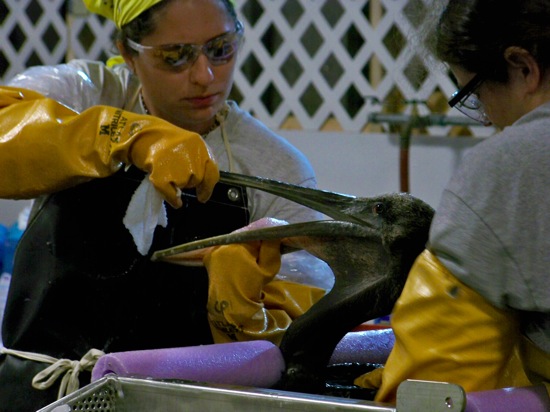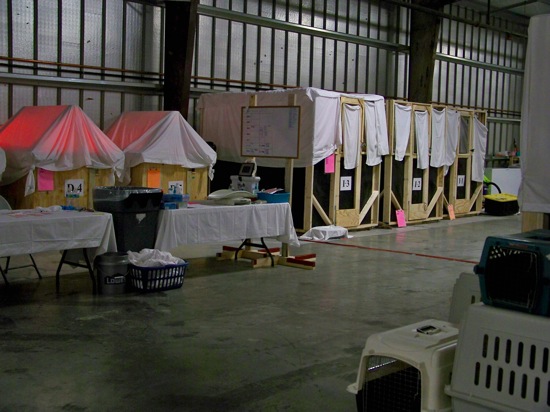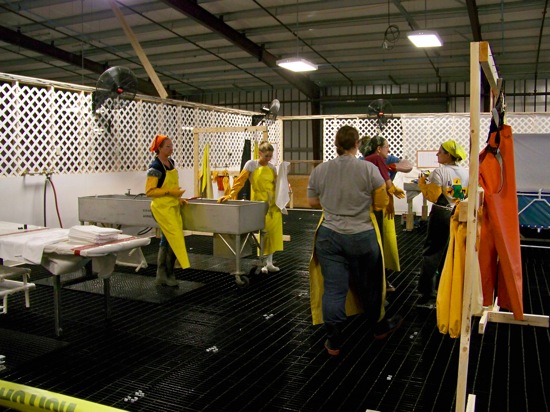A Visit to the Hammond Oiled Wildlife Rehabilitation Center
One of the most striking things about the Hammond Wildlife Rehabilitation Center is that the people working there use terms of war to describe it. They call the oil-spill affected area, “The Arena,” and the oiled intake, intensive care and carcass processing units, “Hot Zones.”
The site is unmarked — no signs along the road announce its presence and even when you arrive at the main parking lot, the only sign to be seen says “Entrance.” Visitors are not welcome here — there is no access for the general public. One-hour tours are offered twice weekly exclusively for the media. We got in by convincing the Joint Incident Command that we were media or at least something vaguely akin to media. The access restrictions are in large part to minimize stress and disturbance on the debilitated animals that are recovering in this frightening, alien environment. However, it is clear that the restrictions are also aimed at tightly controlling the message.
It is an impressive and oppressive facility. Once through security and orientation, complete with detailed lists of do’s and don’ts, our little group from PDX 2 Gulf coast was ushered into the lumber warehouse turned animal hospital. The building has been gutted and new electrical, water, ventilation systems and hospital areas installed; its construction has cost hundreds of thousands of dollars to create and will be dismantled once the oil spill response is completed.
The observation area was bound by yellow caution tape, beyond which we were warned to not step. To the left and right, respectively, were oiled bird exam rooms and the intensive care unit, both hot zones. The exam rooms looked much like a human hospital emergency room with tall, bench-like exam tables, medical equipment and bright lights. A sea of wooden recovery cages approximately 6 feet square and ten feet tall filled much of the building. The bottom half of each was completely enclosed to reduce the stress on the birds inside. Although I couldn’t see them, I could hear faint cries, calls and muffled peeps from some of the birds inside. Banks of lights illuminated the work areas but in this cavernous facility the light seemed to dissipate — it felt dim even when it wasn’t.
Further inside we watched rehab workers dressed in white medical uniforms examining Banded Skimmers. The birds were placed on exam tables but kept covered in white cloths as the workers pulled out a wing, then a leg for inspection. From my vantage point, ten feet from the tables, all that was really visible were two tiny struggling bodies under white sheets.
From there we were taken into the washing area. It was an impressive enclosure, approximately 25 feet wide by 50 feet long containing two rows of three long, stainless steel sinks. The metal grate floor was raised three feet above the rest of the facility in order to accommodate a wastewater collection system underneath. The water coming off these birds is so polluted it must be processed through wastewater treatment equipment. As the volunteers gown up to wash the birds, the toxicity of oil is driven home — they take ample time to carefully cover themselves in heavy rubber boots, chest to floor rubber aprons, rubber gloves that come virtually to the shoulder, and goggles.
The first birds to be carried into the washing facility were Brown Pelicans. These are large, strong birds. It took up to three rehab workers to force them down into the sinks and hold them in place while they were scrubbed and hosed off. First they pinned them and cleaned their eyes with swabs and saline solution. The birds struggled and panted. These amazing cool, giant birds that seem so wonderfully joyous and full of personality in the air and on the water were dull and frightened. They were covered head to toe with a grayish brown film of oil. Their wide eyes looked for escape, the nictitating eyelids blinking repeatedly. It was especially difficult to watch the workers hold their bills open and force their hands down into the birds’ mouths to clean their throats and pouches. I fought hard to keep my tears in check.
I knew that many birds that undergo the stress of rehab ultimately don’t survive it, and I asked our guide, Barbara Callahan of the International Bird Rescue Research Center (IBRC) for her thoughts on the issue. She was a bit evasive but said that pelicans were amongst the hardiest and most resilient and that they had recently spotted a tagged 19 year old pelican that had been through an oil spill rehab process years before. After all, this region has dealt with many, many oil spills.
As with so many experiences during this mission, I was left with mixed feelings and uncertainty about the truth. On the one hand, I saw a clean, efficient well-run facility caring for hundreds of birds. I know that I personally could not deal with the emotional toll of that job day in and day out and I am glad that some people can.
Brown pelicans make-up over 600 of the 1415 animals that have passed through this facility to date. Other animals that are being treated include gulls, spoonbills, terns, skimmers and egrets. Additional facilities in Mississippi, Georgia and Florida have treated another 400+ birds.
Interestingly, unlike most rehab operations, the workers at Hammond were not just volunteers but contractors being paid by BP. And therein lies part of my uncertainty. Even though I believe the staff have good intentions, oil companies are major clients of the International Bird Rescue Research Center. According to Callahan, she and her colleagues travel all over the world to conduct trainings paid for by the oil industry. When we asked our guides about B.P., they quickly responded that they have been “wonderful.” It’s hard to decipher how much of this is about helping birds and how much is about helping BP present a certain image.
At the end of the day, there is nothing good in this for the impacted birds. Those that don’t die directly from the oil are terribly affected by the stress of the rescue attempt. On top of that, many of the surviving birds are juveniles and lose precious weeks of survival learning while in the rehab center.
The only sensible solution is to prevent oil spills from happening. The only real way to do that is to aggressively reduce our consumption of petroleum.
And, while this devastating catastrophe feels far away, in little known Louisiana, keep in mind that Barbara Callahan previously worked on Oregon’s New Carissa oil spill. Yes, it was tiny in comparison, but, just because Oregon doesn’t produce oil certainly doesn’t mean we don’t consume it. There’s a good chance that the gasoline I pump into my Prius in Portland comes from the Gulf Coast.
As I left the rehab center, I realized the caution tape looked just like the tape at a crime scene. I was a witness, but also an accomplice.
Full photo gallery here.
By Cylvia Hayes, CEO 3E Strategies, and Bob Sallinger, Conservation Director Audubon Society of Portland



























1 COMMENT
Cylvia and Bob,
Thank you for the first hand look into one of these oiled wildlife cleaning facilities. This just breaks my heart, yet I’m hopeful that some of the wildlife will survive.
You are spot in in your sentances: “The only sensible solution is to prevent oil spills from happening. The only real way to do that is to aggressively reduce our consumption of petroleum.”
Prevention is key. I always remember the 6 ps: Proper preperation prevents poor performance. A lesson short term thinking companies may never learn.
Thank you for a wonderfully written article.
Best regards,
Kirt
Leave a comment